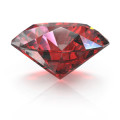What Is Synthetic Ruby?
Synthetic rubies (also known as created, cultured, or lab-grown rubies) are created through an artificial process that usually involves high temperature and pressure.
From a chemical standpoint, lab-created rubies are no different from natural ones and are considered real rubies.
It should be noted that artificially produced rubies are not the same as fake rubies, which have a different chemical structure from that of natural ruby.
Testing If a Ruby Is Synthetic
Testing whether a ruby is created in a lab involves analyzing its physical structure and chemical composition.
Although synthetic and natural rubies are virtually identical, there are some very subtle differences that can be detected with the appropriate equipment.
Structural cues: Gemologists can tell whether a ruby is synthetic by looking at its structure under a microscope.
Rubies have the so-called “growth lines” – structural patterns that occur during the formation of the stone.
The growth lines in synthetics are characteristically curved, indicating the ruby’s artificial origin.
Lab-created rubies may also have microscopic gas bubbles inside, which were formed during the manufacturing process.
Chemical differences: The process for creating a synthetic ruby leaves certain chemical traces in the stone, which are not present in natural gems. For example, tiny amounts of lead can indicate that a ruby was artificially created.
Although testing a stone in a lab is the most precise way to find out a ruby’s origin, it is not always reliable. Gemstone creation processes are continuously improved, and lab-created stones are becoming almost perfectly identical to their natural analogues.
Signs That a Ruby May Be Lab-Grown
If you don’t have the option of sending your ruby to a lab for testing, there are more practical ways to detect whether a ruby might be synthetic.
Take a look at the following cues (but keep in mind that none of them is a definitive proof of a stone’s origin):
Perfect clarity: Lab-grown rubies are created in a controlled process that minimizes internal flaws. As a result, synthetic stones have higher clarity than most natural ones.
This is not to say that a flawless ruby is necessarily artificial, but if such a stone is natural, it will be very expensive.
If a high-clarity ruby is substantially cheaper than a comparable natural ruby, then it is likely that you are dealing with a synthetic stone.
See what natural rubies look like here and here.
Large size: Big natural rubies are a rarity, and they are very pricey. For example, it is easier to produce a synthetic ruby that is 1.5 carats than find one in nature.
However, there is also a limit to how large a lab-grown ruby can be made. (On the other hand, production methods keep improving.)
Nevertheless, if a ruby is reasonably large and still affordable, it might be synthetic.
Lower price: If a ruby is relatively cheap despite having few flaws, being big, and having an intense red color, then this is a clue that the stone might be lab-created.
However, if the price is too low, be aware that the ruby might be fake.
It is a good idea to use for comparison prices of natural rubies with similar color, clarity, and weight; synthetics can be 10-15% cheaper, whereas fakes can cost 90-95% less.
Remember: The surest way to ascertain whether a ruby is synthetic is to either ask for a certificate verifying its origin (if the gemstone has such a document) or send the stone to a lab to have it tested.
Where to Buy Rubies?
We recommend James Allen (read review) because you can take a 360-degree look at any ruby before having it set in a piece of jewelry.
We also recommend Blue Nile and Ross-Simons.














